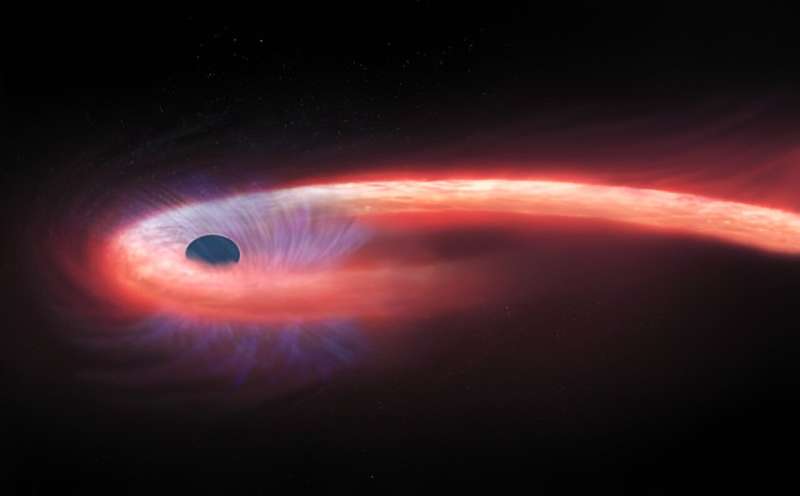January 8, 2024 report
This article has been reviewed according to Science X's editorial process and policies. Editors have highlighted the following attributes while ensuring the content's credibility:
fact-checked
preprint
trusted source
proofread
Study explores the properties of a faint tidal disruption event

Using a spectral synthesis code designed to simulate conditions in interstellar matter, astronomers have explored a faint tidal disruption event (TDE) designated iPTF16fnl. Results of the study, published Dec. 29 on the pre-print server arXiv, deliver important insights into the properties of this TDE.
TDEs are astronomical phenomena that occur when a star passes close enough to a supermassive black hole and is pulled apart by the black hole's tidal forces, causing the process of disruption. Such tidally-disrupted stellar debris starts raining down on the black hole and radiation emerges from the innermost region of accreting debris, which is an indicator of the presence of a TDE. All in all, the debris stream-stream collision causes an energy dissipation, which may lead to the formation of an accretion disk.
Therefore, TDEs are perceived by astronomers as potentially important probes of strong gravity and accretion physics, providing answers about the formation and evolution of supermassive black holes.
Discovered on August 29, 2016, with the intermediate Palomar Transient Factory (iPTF), iPTF16fnl is a relatively faint optical TDE located at the center of the galaxy Markarian 950, some 217 million light years away. It has faster decay timescales than most known TDEs, its black hole is estimated to be about 2 million times more massive than the sun, and the mass of the disrupted star was calculated to be 0.03 solar masses.
In order to shed more light on the properties of iPTF16fnl, a team of astronomers led by T. Mageshwaran decided to employ CLOUDY, which is a numerical spectroscopic simulation code. CLOUDY allowed them to model the optical spectral lines from iPTF16fnl at three different epochs and also to obtain the underlying physical conditions.
The study found that in the case of iPTF16fnl the black hole has a mass of approximately 673,000 solar masses, while the disrupted star is about 2.6 times more massive than the sun. The age of the TDE's host galaxy was estimated to be 650 million years.
According to the paper, the outflow, in the form of a wind blowing from the formed accretion disk of iPTF16fnl has a velocity of about 7,447 km/s and the wind's inner radius was measured to be approximately 1.5 AU. The disk formation time was calculated to be 13.25 days.
The research found that the disk of iPTF16fnl is moderately clumpy and radiatively inefficient. The astronomers underlined that the mass outflow rate dominates the mass accretion rate at early times, but it turned out that the mass outflow rate declines rapidly compared to the mass accretion rate.
Furthermore, the results indicate that the helium-to-hydrogen number density ratio of the wind is between 0.1 and 0.15, therefore comparable to that of the sun. This suggests that the tidally-disrupted star is originally a main sequence star.
More information: Mageshwaran et al, Revealing Physical Properties of a Tidal Disruption Event: iPTF16fnl, arXiv (2023). DOI: 10.48550/arxiv.2312.17417
Journal information: arXiv
© 2024 Science X Network





















